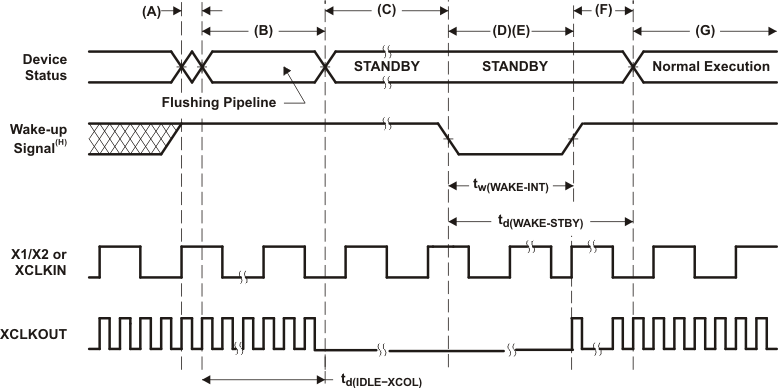ZHCSAH6F November 2012 – September 2021 TMS320F28050 , TMS320F28051 , TMS320F28052 , TMS320F28052F , TMS320F28052M , TMS320F28053 , TMS320F28054 , TMS320F28054F , TMS320F28054M , TMS320F28055
PRODUCTION DATA
- 1 特性
- 2 应用
- 3 说明
- 4 Revision History
- 5 Device Comparison
- 6 Terminal Configuration and Functions
-
7 Specifications
- 7.1 Absolute Maximum Ratings
- 7.2 ESD Ratings – Commercial
- 7.3 ESD Ratings – Automotive
- 7.4 Recommended Operating Conditions
- 7.5 Power Consumption Summary
- 7.6 Electrical Characteristics
- 7.7 Thermal Resistance Characteristics for PN Package
- 7.8 Thermal Design Considerations
- 7.9 JTAG Debug Probe Connection Without Signal Buffering for the MCU
- 7.10 Parameter Information
- 7.11 Test Load Circuit
- 7.12 Power Sequencing
- 7.13 Clock Specifications
- 7.14 Flash Timing
-
8 Detailed Description
- 8.1
Overview
- 8.1.1 CPU
- 8.1.2 Control Law Accelerator
- 8.1.3 Memory Bus (Harvard Bus Architecture)
- 8.1.4 Peripheral Bus
- 8.1.5 Real-Time JTAG and Analysis
- 8.1.6 Flash
- 8.1.7 M0, M1 SARAMs
- 8.1.8 L0 SARAM, and L1, L2, and L3 DPSARAMs
- 8.1.9 Boot ROM
- 8.1.10 Security
- 8.1.11 Peripheral Interrupt Expansion Block
- 8.1.12 External Interrupts (XINT1 to XINT3)
- 8.1.13 Internal Zero-Pin Oscillators, Oscillator, and PLL
- 8.1.14 Watchdog
- 8.1.15 Peripheral Clocking
- 8.1.16 Low-power Modes
- 8.1.17 Peripheral Frames 0, 1, 2, 3 (PFn)
- 8.1.18 General-Purpose Input/Output Multiplexer
- 8.1.19 32-Bit CPU-Timers (0, 1, 2)
- 8.1.20 Control Peripherals
- 8.1.21 Serial Port Peripherals
- 8.2 Memory Maps
- 8.3 Register Map
- 8.4 Device Emulation Registers
- 8.5 VREG, BOR, POR
- 8.6 System Control
- 8.7 Low-power Modes Block
- 8.8 Interrupts
- 8.9
Peripherals
- 8.9.1 Control Law Accelerator
- 8.9.2
Analog Block
- 8.9.2.1
Analog-to-Digital Converter
- 8.9.2.1.1 ADC Device-Specific Information
- 8.9.2.1.2 ADC Electrical Data/Timing
- 8.9.2.2 Analog Front End
- 8.9.2.1
Analog-to-Digital Converter
- 8.9.3 Detailed Descriptions
- 8.9.4 Serial Peripheral Interface
- 8.9.5 Serial Communications Interface
- 8.9.6 Enhanced Controller Area Network
- 8.9.7 Inter-Integrated Circuit
- 8.9.8 Enhanced Pulse Width Modulator
- 8.9.9 Enhanced Capture Module
- 8.9.10 Enhanced Quadrature Encoder Pulse
- 8.9.11 JTAG Port
- 8.9.12 General-Purpose Input/Output
- 8.1
Overview
- 9 Applications, Implementation, and Layout
- 10Device and Documentation Support
- 11Mechanical, Packaging, and Orderable Information
8.9.12.3.4.4 STANDBY Mode Switching Characteristics
over recommended operating conditions (unless otherwise noted)
| PARAMETER | TEST CONDITIONS | MIN | MAX | UNIT | |
|---|---|---|---|---|---|
| td(IDLE-XCOL) | Delay time, IDLE instruction executed to XCLKOUT low | 32tc(SCO) | 45tc(SCO) | cycles | |
| td(WAKE-STBY) | Delay time, external wake signal to program execution resume(1) | cycles | |||
| Without input qualifier | 100tc(SCO) | cycles | ||
| With input qualifier | 100tc(SCO) + tw(WAKE-INT) | ||||
| Without input qualifier | 1125tc(SCO) | cycles | ||
| With input qualifier | 1125tc(SCO) + tw(WAKE-INT) | ||||
| Without input qualifier | 100tc(SCO) | cycles | ||
| With input qualifier | 100tc(SCO) + tw(WAKE-INT) | ||||
(1) This delay time is the time taken to begin execution of the instruction that immediately follows the IDLE instruction. execution of an ISR (triggered by the wake up signal) involves additional latency.

IDLE instruction is executed to
put the device into STANDBY mode.
The PLL block responds to the
STANDBY signal. SYSCLKOUT is held for the number of cycles indicated as follows
before being turned off:
- 16 cycles, when DIVSEL = 00 or 01
- 32 cycles, when DIVSEL = 10
- 64 cycles, when DIVSEL = 11
Clock to the peripherals are
turned off. However, the PLL and watchdog are not shut down. The device is now
in STANDBY mode. After the IDLE instruction is executed, a delay of 5 OSCCLK
cycles (minimum) is needed before the wake-up signal could be asserted.
The external wake-up signal is
driven active.
The wake-up signal fed to a GPIO
pin to wake up the device must meet the minimum pulse width requirement.
Furthermore, this signal must be free of glitches. If a noisy signal is fed to a
GPIO pin, the wake-up behavior of the device will not be deterministic and the
device may not exit low-power mode for subsequent wake-up pulses.
After a latency period, the
STANDBY mode is exited.
Normal execution resumes. The
device will respond to the interrupt (if enabled).
From the time the IDLE
instruction is executed to place the device into low-power mode, wakeup should
not be initiated until at least 4 OSCCLK cycles have elapsed.
Figure 8-49 STANDBY
Entry and Exit Timing Diagram